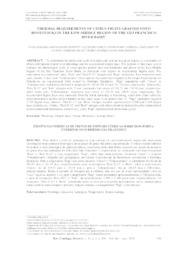Thermal requirements of citrus fruits grafted onto rootstocks in the low-middle region of the São Francisco river basin.
Thermal requirements of citrus fruits grafted onto rootstocks in the low-middle region of the São Francisco river basin.
Autoria: NASCIMENTO, F. S. S.; RIBEIRO, V. G.; BASTOS, D. C.; SÁ, J. F. de; NASCIMENTO, P. H. D.
Resumo: To understand the production cycle of a particular cultivar in a given region, it is necessary to obtain information related to its phenology and the accumulated degree days. The purpose of this study was to evaluate the phenological cycle of citrus species grafted onto two rootstocks and grown in the Low-Middle Region of the São Francisco River Basin, in particular with respect to accumulated degree days. The experiment was conducted using ‘Rubi’ and ‘Pera D-12’ oranges and ‘Page’ mandarins. Two rootstocks were used, namely ‘Cravo’ and ‘Volkameriano’ lemon species that were drip irrigated in the Campo Experimental de Bebedouro, an experimental field owned by Embrapa Semiárido. ‘Page’ mandarins with ‘Cravo’ or ‘Volkameriano’ rootstocks exhibited a subperiod (0–10) of 183.32 and 181.24 days, respectively. Meanwhile, ‘Pera D-12’ and ‘Rubi’ oranges with ‘Cravo’ rootstocks had values of 249.57 and 178.58 days, respectively, while those with ‘Volkameriano’ rootstocks had values of 226.35 and 200.41 days, respectively. The accumulated degree days were measured from the initial sprouting to harvesting, which took place when the fruits presented a soluble solids/titratable acidity ratio equal to or greater than 12. ‘Page’ andarins required 2,720 degree days, whereas ‘Pera D-12’ and ‘Rubi’ oranges required approximately 3,390 and 2,280 degree days, respectively. Finally, ‘Pera D-12’ and ‘Rubi’ oranges with either rootstock presented cycles characterized as mid-season and precocious, respectively, while ‘Page’ mandarins had precocious cycles.
Ano de publicação: 2018
Tipo de publicação: Artigo de periódico
Unidade: Embrapa Semiárido
Palavras-chave: Bioma Caatinga, Caatinga, Citricultura, Degree days, Fenologia, Graus dia, Laranja, Mandarin, Porta Enxerto, Tangerina, Vale do São Francisco
Observações
1 - Por padrão são exibidas publicações dos últimos 20 anos. Para encontrar publicações mais antigas, configure o filtro ano de publicação, colocando o ano a partir do qual você deseja encontrar publicações. O filtro está na coluna da esquerda na busca acima.
2 - Para ler algumas publicações da Embrapa (apenas as que estão em formato ePub), é necessário ter, no celular ou computador, um desses softwares gratuitos. Sistemas Android: Google Play Livros; IOS: iBooks; Windows e Linux: software Calibre.
Acesse outras publicações
Acesse a Base de Dados da Pesquisa Agropecuária (BDPA) para consultar o acervo completo das bibliotecas da Embrapa.

